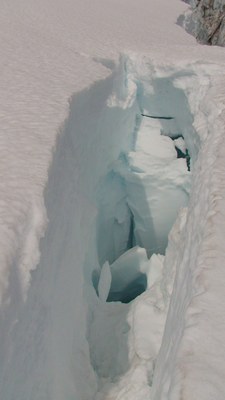
Backcountry Skiing Course
Glacier Skiing/Snowboarding and Crevasse Rescue
Teaches rope skills necessary to effect a crevasse rescue.
- Thu, Apr 18, 2024 - Thu, May 16, 2024
- Committee: Foothills Backcountry Skiing Committee
- Members: $495.00 Guests: $595.00
- Availability: 1 (12 capacity)
- Cancellation & Refund Policy
This course is for those with competent backcountry skiing or snowboarding skills who desire to safely travel on glaciers and to perform crevasse rescues. You must be able to ski or board the equivalent of an ungroomed single black diamond slope with a weighted day pack whose weight is the equivalent of a glacier rope and crevasse rescue gear, and to climb ~2,500 feet at 800-1000ft per hour. This course includes work shops, optional practices and a 2-day field trip at Mt. Rainier where the students will practice roped travel and crevasse rescue. Completion of this course prepares you to ski or snowboard on Mountaineer trips rated M1G, M2G and M3G. The course provides instruction on: route finding, traveling and camping on glaciers, belaying, prusiking, and crevasse rescue systems.The required equipment includes
- metal edge skis and climbing skins or snowboard with an uphill climbing system (skins, approach skis or snowshoes)
- shovel (metal)
- avalanche probe
- avalanche transceiver (3-antenna)
- crevasse rescue equipment
- Harness, carabiners, prusiks, slings
- Full equipment list provided with course materials.
Badges you will earn:
This course has no scheduled activities.
-
Glaciers! The Art of Travel & the Science of Rescue by Michael Strong, et al (digital copy will be provided)
-
Topographic Map of the Nisqually Glacier and Paradise area of Mount Rainier National Park
-
Skis or splitboard with metal edges
-
Ski or Snowboard Boots
-
Climbing skins or snowshoes
-
Day pack
-
Lightweight gloves with fingers for tying knots
-
Avalanche transceiver (3-antenna)
-
Shovel (metal)
-
Avalanche Probe (NOT probe ski poles)
-
Black Diamond ATC or essentially identical belay device (see course material for acceptable types; in particular, avoid unusual/asymmetrical shapes, etc.)
-
2 Pulleys (see course material for requirements and suggestions)
-
Seat harness. Leg loops that can release/unbuckle are ideal. Example: Black Diamond Couloir.
-
Ice Axe and leash whose length is at least as long as the shaft, minimum 55cm. No ice tools, straight or slightly curved shaft only.
-
1 Locking (Autolock) pear-shaped/HMS carabiner to be used as the Rope Carabiner
-
3 Locking (Screw Lock) carabiners to be used as the Prusik, Initial Anchor and Main Anchor Carabiners
-
7 regular (straight gate) carabiners to be used as the Ice Axe, Pack Tether, Chest Sling and Pulley Carabiners. These should be oval shaped and standard size (not undersized).
-
Prusik Slings tied from 6 mm Perlon or equivalent (a type of Nylon). See below for details on the lengths you need for each prusik. When you are done, you will have:
-
1 Texas Foot Prusik
-
1 Texas Foot Prusik tether
-
1 Texas Harness Prusik
-
1 Pack Tether
-
4 Tie-off loops to be used for the Initial Anchor, Pack Prusik and 2 extras
-
Below are the lengths of 6 mm Perlon you should cut/purchase for each prusik, based on your height. This are straight line, untied, lengths, i.e. not the length after being tied into prusiks, etc.
-
The different colors (i.e., A, B, C and D) are recommended and not required. They are intended to keep the different prusiks more apparent and no specific color is required.
|
Color A |
Color B |
Color C |
Color D |
|
|
Student Height |
Foot Prusik |
Foot Prusik Tether |
Harness Prusik and Pack Tether |
Tie-off Loop |
|
6’ 1” - 6’ 6” |
13’ |
4' 6” |
6' 6” (x2) |
4' (x4) |
|
5' 8” - 6' |
12' |
4' |
6’ (x2) |
4' (x4) |
|
5' 2” - 5' 7” |
11' 6” |
4' |
5' 6” (x2) |
4' (x4) |
|
Under 5' 2” |
11' |
4' |
5’' (x2) |
4' (x4) |
-
Runners, either pre-sewn or tied from 1” webbing (but NOT both). Pre-sewn runners will be lighter, if slightly more expensive. These can be nylon or dyneema.
-
1 Single Runner to be used for the Initial Anchor
-
1 Double Runner to be used for the Main Anchor
-
Chest Sling
The different colors are recommended and NOT required. They are intended to keep the different runners more apparent and no specific color is required. Use 1” webbing or pre-sewn and NOT BOTH.
|
Runner |
1” Webbing |
Pre-Sewn |
Suggested Color |
|
Single Runner |
5’6” |
24” |
Not red, preferably green |
|
Double Runner |
9’6” |
48” |
Red |
|
Chest Harness Sling |
7’6” |
*see note |
Not red, preferably blue |
*Chest sling note: Pre-sewn runners most likely to fit as a chest sling are the 36” and 48” lengths. If a pre-sewn runner at one of these lengths fits you for a chest sling, great! Get it. If, however, these lengths do not work for you, just get the 1” webbing to make a chest sling, and you will be able to tie it to whatever size you need.
- Climbing or skiing helmet (victims are required to wear a helmet while they are in a crevasse)
You must register for this course to see course materials.

 Glacier Skiing & Crevasse Rescue Course
Glacier Skiing & Crevasse Rescue Course